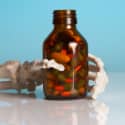The Many Consequences of Addiction
Addiction can unleash devastating consequences that wreak havoc on every aspect of an individual’s life. The effects of drug or alcohol abuse extend far beyond the initial euphoria and can lead to a spiral of guilt, despair, and depression.
The negative emotions intensify as the individual becomes more deeply entangled in addiction. And this further fuels the vicious cycle. The guilt accompanying addiction stems from the awareness of the harm caused to oneself and others.
The addicted person may feel remorseful for neglecting their responsibilities and letting down loved ones. This overwhelming guilt can lead to self-loathing, making the individual even more prone to use drugs and alcohol.
Physical Consequences of Addiction
In addition to the mental stress created by unethical behaviour, the addicted person’s body also adapts to the presence of the drugs. He will experience an overwhelming obsession with getting and using the drugs and will do anything to avoid the resulting pain when withdrawing from them. The person has develops an insatiable thirst for the drug.
He now seeks drugs for what little “pleasure” he gets from them. But he mostly takes them to avoid withdrawal’s mental and physical anguish. The individual is now in a vicious, dwindling spiral. The drugs he abuses have changed him both physically and mentally. And his life is drastically different.

Stages of
Addiction
Drug
Overdose

Addiction & "Drug Personality"
It is important to understand that the “drug personality” is not an inherent trait but a consequence of drug-induced changes. These changes can lead to a range of behavioural and psychological shifts that give the appearance of a distinct unrecognizable personality.
The shift can lead to neglect of personal hygiene, health, and professional obligations. The person can exhibit increased secrecy and defensiveness with a growing sense of isolation. A breakdown of open communication with friends and family often occurs.
It also attacks one’s ambition and capacity to learn, and once was a caring person who now seems indifferent. Such traits help us establish a link between drugs and increasing difficulties with crime, production, and the modern breakdown of social and industrial culture.

Alcohol
Overdose
Understanding
Cravings

Quitting and Cravings
When the person initially tries to quit, his cells become used to large amounts of these metabolites and are now forced to deal with much-decreased amounts. (Metabolites are substances made or used when the body breaks down drugs or alcohol, which gets trapped in the fatty tissues.) Even as the withdrawal symptoms subside, the “demand” for the drug is still present.
Craving is an extremely powerful urge and can cause a person to create all kinds of “reasons” they should begin using drugs or drinking again. He is now in an endless cycle of trying to quit, having cravings, returning to the drug, and fearing withdrawal.
Suggested reading:
- Understanding cravings and how to minimize them.
- Avoiding relapse.
Alcohol and Drug Addiction – Relapse & Cravings
Eventually, the body will again become used to having lowered drug metabolites. But, because deposits of drug or alcohol metabolites releasing from the fatty tissues back into the bloodstream for years, craving and relapse remain a cause for concern. Left unhandled, the presence of metabolites, even in microscopic amounts, causes a reaction as if the person had again actually taken the drug and can set up cravings and relapse even after years of sobriety.
Some drug rehabilitation treatments will address this aspect of addiction or alcohol abuse, while others do not. Finding the right drug rehabilitation treatment is crucial for successful rehabilitation.
Find out more about treatment types here.

Alcohol and
Depression
Drug Induced Psychosis


Addiction Series
- Alcohol and Depression
- Alcohol, Dangers in Stopping
- Alcohol Overdose
- Addiction – Beginning
- Addiction Symptoms
- Addiction Consequences
- Drug-Induced Psychosis
- Drug Overdose
- How to quit crack cocaine?
- It’s Difficult to Quit Drinking
- Overlooking Addiction & Diagnosing Depression
- Stages of Addiction
- Quitting Weed
- The Functional “Addict” Defined
- Understanding Cravings
- What is Addiction?
- Alcohol and Depression
- Alcohol, Dangers in Stopping
- Alcohol Overdose
- Addiction – Beginning
- Addiction Symptoms
- Addiction Consequences
- Drug-Induced Psychosis
- Drug Overdose
- How to quit crack cocaine?
- It’s Difficult to Quit Drinking
- Overlooking Addiction & Diagnosing Depression
- Stages of Addiction
- Quitting Weed
- The Functional “Addict” Defined
- Understanding Cravings
- What is Addiction?
Find out more about us.

Marc J. Bernard
Author,
Substance Use Disorder & Recovery Professional,
Referral & Consultation Counsellor






